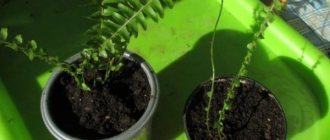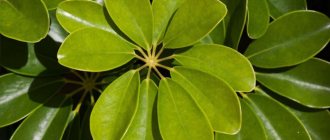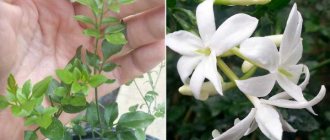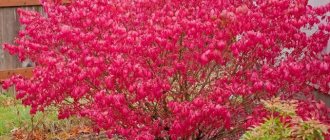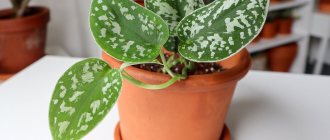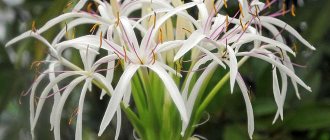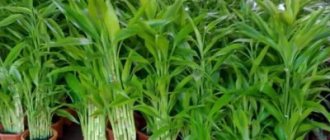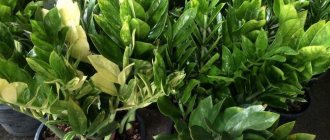Types and varieties of ferns for home cultivation
There are a lot of varieties of fern, but not all are suitable for growing indoors. Among the home collections you can find the following types:
- Maidenhair. It has thin, slightly translucent leaves of light green color on graceful black stems. Suitable for growing in damp and cool areas.
- The common ostrich is distinguished by its original leaves, similar to the feathers of ostriches.
- Orlyak. This plant can grow up to 70 cm in length, its leaves are hard and single. It is considered a medicinal type of fern.
- Nephrolepis is beautiful, quite large, its leaves are hard, long, light green. In some plants they grow vertically, eventually drooping, in others they are wavy, immediately drooping down. There are many varieties of this variety. They are the ones most often chosen for growing at home.
- The male shield plant is a powerful large plant with light green leaves. It is considered poisonous, but healing.
- Female kochedyzhnik is distinguished by openwork, dissected leaves; in everyday life it is often used to fill aquariums.
Attention! Nephrolepis varieties are usually chosen for growing at home. These flowers are beautiful, hardy and relatively easy to care for.
Female kachedyzhnik (Athýrium fílix-fémina)
Male shieldweed (Dryopteris fílix-mas)
Nephrolepis
Bracken (Pteridium aquilinum)
Ostrich (Matteuccia struthiopteris)
Fern in a pot - indicator of indoor microclimate
Fern is considered a resilient plant, however, some rules of care and conditions for its good growth must be observed. And if in nature the plant will grow wonderfully in sandy or peaty soil, and will do well without replanting and pruning, then in an apartment, even in the most ideal soil, it can begin to wither. The reason for this may be an unfavorable indoor microclimate.
The fern is sensitive to the atmosphere in which it is located, and is a kind of litmus in determining the purity of the air. Ferns begin to die and get sick in conditions of gas pollution and smoke in the environment. They do not tolerate too dry air well, so one of the main conditions for the growth of this plant is good access to fresh air.
Poor growth and slow death of ferns is a reason to think about the environmental situation in your house or apartment. It is likely that there is a gas leak in the house, or it is time to buy a kitchen hood. It is also worth checking the humidity level: it may make sense to purchase a humidifier.
Important! If, despite following the basic rules of care, the fern continues to wither, it makes sense to think about the quality and humidity of the air in the room. Ferns react sharply to gas pollution and low humidity levels.
Platycerium
A very interesting type of fern is Platycerium, or Antlers (Platycerium). This is a rare plant, you can find it in greenhouses or among flower growers who are truly passionate about their work. In nature, a few representatives of this species live in Australia, India and some areas of Africa.
Like many other ferns, Platycerium is an epiphytic plant and in nature can reach very large sizes. The smooth long fronds of the platicerium, thanks to the original dissection, look like the antlers of a deer, for which it was nicknamed that way.
The peculiarity of this fern is that it has two types of fronds - some are long, up to 1 meter and smooth, while others have special depressions in the form of pockets. Moisture, insect remains, seeds of various plants and leaves accumulate in these bins. Over time, all this rots, and the resulting organic matter nourishes the plant.
Platycerium does not form spores and is propagated only by lateral layering, which appears quite rarely. Most often, gardeners place deer antlers in hanging flowerpots or attached to driftwood. For pots, make a soil mixture from bark, moss, branches, or buy ready-made soil for orchids. If deer antlers are grown on driftwood, then you need to provide the plant with the necessary air humidity, and when watering, immerse the snag in water so that it is saturated with moisture.
Fern home care at home
Varieties of nephrolepis are not only hardy, but also decorative, so they will perfectly decorate the interior of a house, apartment or office space. Depending on the lighting and the composition of the soil in the pot, the color of the leaves can vary from delicate light green to rich green.
Lighting, location, temperature
The plant adequately perceives shadow, so it can be placed even in the corner farthest from the window. But this does not mean that it does not need light at all: scattered sunlight should fall on the leaves. If there is a place in the corner opposite the window or at the south-west window opening, it is better to give it to the fern.
The perennial plant is quite large in size, growing gradually both in height and width. It is unlikely that it will be possible to place it on a windowsill; it needs space.
The ideal air temperature for indoor ferns is about 20 degrees. Theoretically, the plant can withstand a jump of up to 12 degrees, but there is no point in doing such an extreme on purpose.
Watering and spraying
The fern prefers moderate, and most importantly, regular watering. The soil in the pot where nephrolepis grows should always be slightly moist, but at the same time not waterlogged. If you ignore this point, first dry it and then pour it abundantly into the flower, you can provoke rotting of the fern roots. Watering the flower two or three times a week will be quite enough, and you should also spray it. Rainwater or soft, settled water is suitable for irrigation.
If the air in the room is too dry, you will have to spray the plant more often - every day. In moderate humidity, two or three times a week is enough. Watering and spraying can be combined or alternated between these procedures.
Attention! Moderate regular watering with soft water (temperature about 20 degrees) and a little sunlight are the main conditions for plant health.
The soil
For planting and further good growth of the nephrolepis fern variety, you need soil that is similar in structure and composition to that to which the plant is accustomed in nature: loose, with rotted leaves, pine needles, and peat residues.
The soil for planting should be slightly acidic, ideally with admixtures of sand and humus, as well as turf, peat, and leaf soil. Mandatory conditions are water permeability and looseness of the substrate.
In compacted soil, water can stagnate and the roots can begin to rot. As a result, the plant will get sick and die. The first sign of soil that is too wet is brown or brown spots on the leaves. Subsequently, you can even see the leaves drying on the fern. The same signs will appear if the air or soil is too dry.
Top dressing
Experts assure that ferns do not need to fertilize too often: twice a month will be enough. Mineral or organic fertilizers will be quite suitable for feeding. With the latter, you can make a mistake and dilute too concentrated a solution. It is better to dilute minerals according to the instructions.
Know! The best soil for ferns is with admixtures of peat, humus and sand.
Spraying ferns
The air humidity required for ferns can be achieved by spraying. In addition to humidity, ferns also need fresh air, so the room should be ventilated from time to time, especially in hot weather when frequent spraying is done. The optimal air humidity for most ferns is 70-80%. But ferns with thin, delicate leaves need even more humid air - up to 90-95%. Dry air can cause ferns to turn yellow at the edges of their leaves. If you can spray the plants daily, it will benefit the plant. Ferns with thin, delicate leaves that love high humidity require frequent watering and repeated spraying per day. Unfortunately, even regular spraying of fern leaves increases air humidity only near them and for a short time. Air humidity can be increased by placing plants on trays with damp sand, moss, peat or expanded clay, as well as placing containers of water or a humidifier between the plants.
When spraying ferns, it is better to use softened water. The water temperature should be slightly above room temperature. It is not recommended to spray ferns in bright sun and at low temperatures. In winter, it is best to spray ferns in the first half of the day. It is especially important to spray ferns after transplantation for a month until they take root.
Source
Transplantation and propagation
Ferns of any variety and type can be replanted every year. In order not to harm the roots, it is better not to replant, but to replant the flower. When replanting, you need to take a pot a couple of centimeters larger, carefully, without injuring the roots, transfer the flower with soil into it and add the earthen mixture. The best time is the beginning of the growing season, that is, spring. During autumn transshipment, the plant may take a long time to take root, and may even get sick.
If the bush is large and daughter bushes have already appeared, the fern can be divided, thus propagating the plant. It is better to create greenhouse conditions for small plants. There is a possibility that the new daughter shoot, even if it has a root, will not take root. Despite this, this method is the most convenient for reproduction.
Seed propagation (by spores) is a complex process and is not possible under indoor conditions, but Chelyabinsk gardeners have already learned to propagate ferns by seeds. Watch the video to see how the process of seed propagation occurs.
Features of care
Caring for indoor ferns is generally not difficult, but you should train yourself to do it regularly. Rare but abundant watering has a bad effect on the growth and appearance of the plant.
Before planting a plant at home, you need to select a special soil for it, which contains the following components:
- peat;
- needles;
- leaf humus;
- sand;
- garden soil or purchased soil.
The first two components are taken in small quantities - they slightly acidify the soil. This is necessary for the absorption of phosphorus, since its dissolution is possible only in an acidic environment.
Due to its looseness, the soil should allow excess water to pass through well and also be breathable. This is how epiphytic ferns grow on trees. Drainage made of pebbles, expanded clay or broken bricks is laid at the bottom to drain water. It takes up a third of the pot.
Watering
An important condition for irrigation is soft, settled water. You cannot use tap water, otherwise a white layer of salt will form on the ground - these are calcium and magnesium oxides.
In summer , at a temperature of 20 - 24 degrees, water twice a week. In winter, once is enough, provided that the temperature is not lower than 16 degrees .
It is strictly forbidden to add cold water to the soil in hot weather. This causes stress and the root system begins to rot.
Important! If you water the plant heavily in winter, its shoots will be elongated and its leaves will be sparse, since there is little sunlight.
Feeding
Caring for a house fern involves regular feeding during the growing season - in spring and summer. You can use any complex mixtures - mineral or organic. It is important that they contain a full range of macronutrients.
Organic matter in the form of mullein or chicken droppings, which are diluted strictly according to the instructions, is suitable.
In winter, feeding is stopped so that the plants can survive the dormant period normally.
Trimming
Each part of the plant is very important in the life of the entire plant, so pruning the fern should only be done in emergency cases if:
- parts of the plant are injured or damaged (for example, by sunlight or cold air);
- the plant is damaged by insects or disease;
- there is a need to stimulate the growth of fresh foliage.
If pruning still needs to be done, it is better to do it not at the peak of growth. For an indoor fern, 1-2 trimmings per year is sufficient. Old leaves that have turned yellow from time and age of the flower should be cut with pruning shears or garden shears. There is no need to trim tendrils or parts of roots that hang down. If you want to make them invisible, you can twist them and “hide” them in a pot, above the soil, securing them with wire.
Please note! The best option for propagating a flower at home is to plant a large plant. Reproduction by spores is an extremely complex process.
Problems with growing ferns at home
Having planted a house fern, you need to understand that only high-quality care at home will minimize its diseases and will guarantee that pests will bypass a healthy and strong flower. One of the causes of disease and weakening of ferns is violation of watering rules.
Many gardeners note: at some point they discovered that the leaves on the flower turn yellow or brown spots appear on them. In this case, the destructive process begins from the edges, and the entire leaf gradually disappears. But the disease should not be confused with the natural process of dying off old leaves.
Improper watering can also cause nematodes to appear in the soil. In this case, the plant can only be saved by replanting and changing the soil, and even then not always. The insect settles in foliage and rhizomes, so it is extremely difficult to rid the fern of it. One of the drugs that helps in the treatment of this pest is a solution of the drug “Ateplik”.
Unsuitable, too dry air can cause the appearance of aphids, thrips, and scale insects. As a preventive measure against these pests, you need to regularly spray the plant. If infection occurs, you can try spraying it with a solution of Karbofos or the same Aktelik.
Important! The process of dying off of old foliage should not be confused with fern disease or the effect of pests on everything, including very young leaves.
Excessive sunlight can cause foliage to become faded, combined with brown spots. The pallor of the leaves will indicate, on the contrary, its deficiency or lack of nutrition for the plant.
The cause of poor growth will most likely be a small pot, and blackening and rotting of the foliage will appear due to a fungal infectious disease of a plant such as indoor fern. Photos published by amateur and professional flower growers on the Internet will allow you to more accurately determine what exactly your flower is sick with.
Structure of a houseplant
Ferns belong to the category of lower plants. They have the characteristics of ancient ancient plants, but have perfectly adapted to new conditions, embodying changes that meet the requirements of the development of flora, which is confirmed by fern research.
Its unique scaly leaves, or fronds, in the upper part of the flower are large and have a feathery complex shape. The young developing leaves of the plant are wrapped in a snail-shaped spring. As they grow, they gradually acquire a pinnately carved shape, a darker color and become dense. The roots of the plant are in the ground.
Folk signs and beliefs about ferns
Many flower growers and florists do not lose sight of various folklore signs. Regarding fern, they differ radically: some claim its positive effect on the spiritual atmosphere in the house, others say the opposite. It’s better to be optimistic and not give up on growing this flower at home. This is what the popular voice prophesies to the owners of the fern:
- Peace and quiet. If there is a fern in the house, there will be no temper and aggression here, the residents will become softer and more tolerant, friendlier and more restrained. The plant will have the same effect on the atmosphere in the house as a whole.
- Harmony in relationships. This is especially true for families whose members have different temperaments. Thanks to the fern, experts say, people will get along even better, and harmony and happiness will reign in the family.
- Good luck in all your endeavors. Fern attracts fortune and material success, even sudden wealth to the most gamblers. The plant will protect against waste and make its owner lucky.
- Amulet. They say that fern is able to scare away all evil spirits from the house, protect against witchcraft and magic, and become a family amulet.
Important! The fern will give harmony and peace to the home, improve relationships between family members and attract good luck to the owners.
Read : Fern in the house signs
Fern is a beautiful, elegant, and also useful plant in any everyday life. It will not only decorate the interior and make it cozy, but will also be useful. On the one hand, any greenery in the room is a natural source of clean air; for a living or work space this is a more than important factor.
On the other hand, a fern is an indicator of the state of the atmosphere in an apartment or office. And if you believe folk superstitions, fern bushes will have a positive impact on the harmony and well-being of the family in whose house the fern grows.
